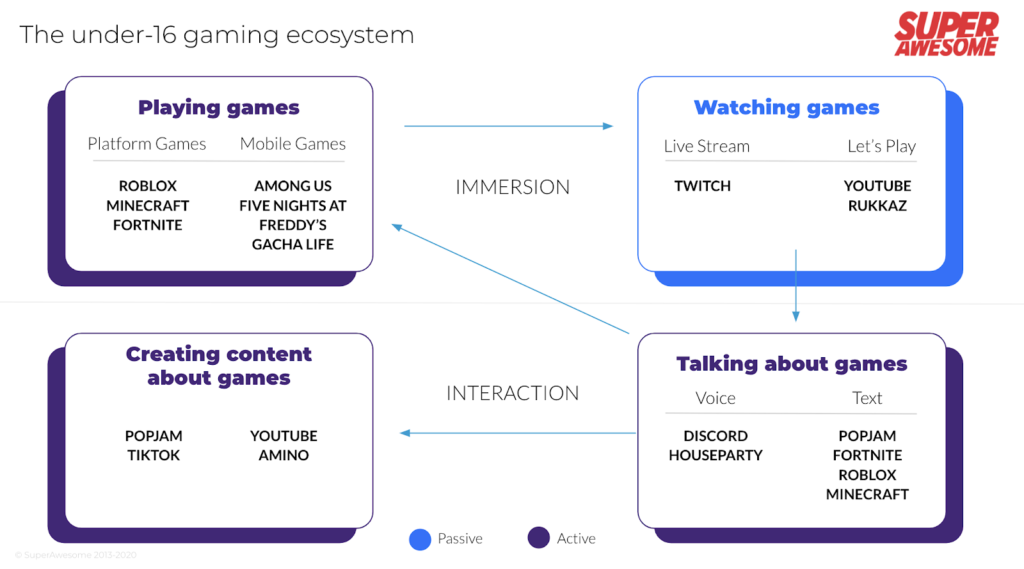Our #Kidtech podcast provides insight into the ever-changing world of kids digital media. In episode 6, SuperAwesome CEO Dylan Collins spoke with Nancy MacIntyre, CEO of Sandbox Kids, a global provider of multi-platform digital subscription services for children and families. They discussed how kids and family content has changed with technology, the expectations young audiences have for content today, and how developers can create safe digital experiences without sacrificing quality.
Check out the highlights of their conversation below to learn more about how the kids and family content ecosystem has evolved and what this means for brands and developers.
The mobile app store made gaming dominant in the kids and family content ecosystem
MacIntyre can pinpoint the exact moment when she recognized that the kids and family content ecosystem began to shift from passive experiences to active, two-way engagement.
“It’s 2009, and the iPhone has just come out…and it feels like every time I go into a restaurant, I see a mom handing a phone to a 2-year-old…I realized in an instant that mobile phones were going to change everything,“ recalled MacIntyre.
“I [also realized that] the app store was going to change how parents thought about content for their kids. It was a no-risk proposition to download an app and it was a no-risk proposition to do a free trial. So I sort of saw the change in the parent dynamic, the accessibility of content, the no-risk association with getting the content.”
This accessibility, propelled by the development of emerging technology, would inevitably lead to changing content consumption preferences for kids (under 13) and Young Teens (under 16). For example, while linear TV viewership continues to decrease, 63% of kids ages 7-9 now play mobile games.
“Traditionally, when you think about kids media companies, you think about Nickelodeon and Cartoon Network,” said MacIntyre. “In today’s world, you think about Roblox [and] Minecraft.”
Young audiences now expect to be active participants in content
Today, youth content consumption preferences require that brands offer new and exciting ways to interact with content — both passively and actively. This shift is propelled by the evolving under-16 gaming ecosystem, which offers young people new and exciting ways to engage with their favorite characters.
“When I worked at Lucasfilm…LEGO Star Wars was launched and there were a lot of questions about whether the consumer would want to mash up two things that they loved so much,” shared MacIntyre. “Does anybody want a LEGO Darth Vader? Well, it turns out everybody wants a LEGO Darth Vader. And everybody wants to be able to create their own characters and morph the Star Wars IP into LEGO. I see the same exact thing with Roblox, that Roblox means the ability to create and morph to your own desires and share it with your friends.”
The youth gaming system has evolved beyond simply playing games, as demonstrated by the popularity of platforms like Roblox. Youth audiences now seek two-way content experiences, from creating content about games to talking about games with their friends.

Learn more in our free report: How the kids gaming ecosystem has changed.
“[Roblox has] become an IP that stands for kids’ imagination and creativity,” MacIntyre explained. “It’s not story-driven, with characters, per se, where kids are focused on the characters and the story. They’re creating the story with the games and they’re experiencing other people’s creations… It’s an IP in and of itself that stands for creativity and sharing.”
Despite the rapid growth of youth media consumption, kids and Young Teens are under-served in the digital space
Young audiences are spending more time online than ever before. But as global regulators and legislation react to this increased consumption, many developers are focused on simply checking a box to ensure compliance instead of putting kids at the heart of the experiences they are creating.
“Kids’ media consumption and technology consumption is growing at a much more rapid rate than it is for adults,” said MacIntyre. “What we have primarily seen is that the big platform companies have invested more in trying to make the internet and kids’ services safe than they have in actually trying to make kids services and products themselves.”
With a specialist kids digital privacy partner, like Kids Web Services, developers can create rich digital experiences for kids and Young Teens without sacrificing quality or worrying about legal compliance.
“Make a product that’s built from the ground up, that’s actually for children, and makes kids’ online experiences better,” said MacIntyre. “You’re not just building a product and marketing it, putting it on the shelf at Walmart, and hoping it sells…you have to constantly be evolving it and making it work better and making the customer love it even more.”
Want to learn more about the ever-changing kids and family content ecosystem?
Listen to the full episode below, or on Spotify, iTunes, and Amazon Music to hear more about Nancy’s thoughts on the current state of the kids content ecosystem, strategies for building a business in the kids space today, and predictions for the future of children’s media.

